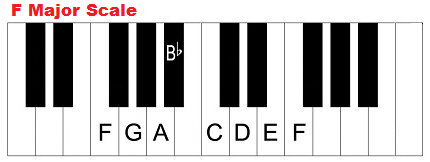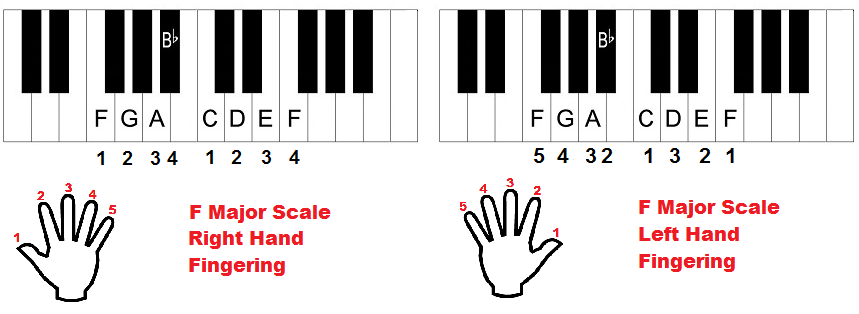This lesson is all about the F major scale. What are the notes of this scale? Its notes are F – G – A – Bb – C – D – E – F. There is one flat in this scale. It’s B flat. Like any other major scale the F maj scale has a total of seven notes plus the F note repeats in a higher octave.
Highly Recommended: Click here for one of the BEST piano/keyboard courses I’ve seen online.
Let’s talk about the intervals in this scale. The first note of the scale, F is called the tonic. The 2nd note, G is the major second. The 3rd note, A is the major third. The 4th note, Bb is the perfect 4th of the scale. The 5th note, C is the perfect fifth. The 6th note, D is the major sixth. The 7th note E is the major seventh and the 8th note, F is a perfect eighth.
Here’s a diagram of the F major scale on the piano keyboard. We can see the note names and where they are on the keyboard.
Here’s a diagram of the scale on the treble clef.
Here’s a diagram of the scale on the bass clef. 
Video:
In terms of scale degrees, F is the tonic of the F major scale. G is the supertonic. A is the mediant. Bb is the subdominant. C is the dominant. D is the submediant. E is the leading tone and F is the octave of the scale.
There is a formula for forming this scale and any other major scale. That formula is W-W-H-W-W-W-H. This stands for whole step, whole step, half step, whole step, whole step, whole step, half step. What does this mean?
First of all a half step (also called a semitone) is the shortest distance between two keys on your piano. It’s the shortest distance in Western music. For instance C to C sharp is a half step. E to F is a half step. Two half steps make up a whole step (or whole tone). For instance, C to D is a whole step, and F to G is a whole step as well. A whole step means that you should skip a key. A half step means that you should play the next key.
Using the formula, W-W-H-W-W-W-H, when we start on F, we move one whole step to G, one whole step to A, a half step to Bb, a whole step to C, a whole step to D, a whole step to E and a half step to F. And there we have it… the F major scale.
The relative minor of F major is D minor. Both scales make use of the same notes. The difference is that for F major, F is the first note, while for D minor, D is the first note. The notes of the D minor scale are D – E – F – G – A – Bb – C – D.
Here are the fingerings for this scale. The numbers indicate the fingers to be used for each note. For either hand, the thumb is finger 1, index finger is finger 2, middle finger is 3, ring finger is 4 and pinky finger is 5.
Fingerings (Left Hand): 5, 4, 3, 2, 1, 3, 2, 1
Fingerings (Right Hand): 1, 2, 3, 4, 1, 2, 3, 4
Video: How to Play F Major Scale
Let’s now talk about the diatonic triads for these scale. There’s a triad chord for each note of the F major scale. These chords are as follows: F major, G minor, A minor, Bb major, C major, D minor and E diminished. (F – Gm – Am – Bb – C – Dm – Edim.)For further reading on the chords in the key of F major, go here.
Modes of the F major scale:
- Ionian/Major Scale: F, G, A, Bb, C, D, E, F
- Dorian: G, A, Bb, C, D, E, F, G
- Phrygian: A, Bb, C, D, E, F, G, A
- Lydian: Bb, C, D, E, F, G, A, Bb
- Mixolydian: C, D, E, F, G, A, Bb, C
- Aeolian/Natural minor scale: D, E, F, G, A, Bb, C, D
- Locrian: E, F, G, A, Bb, C, D, E
Notice that the Ionian mode is the same as the Major scale. The Aeolian mode is also the same as the Natural minor scale.
Piano Keyboard Lessons Home Page